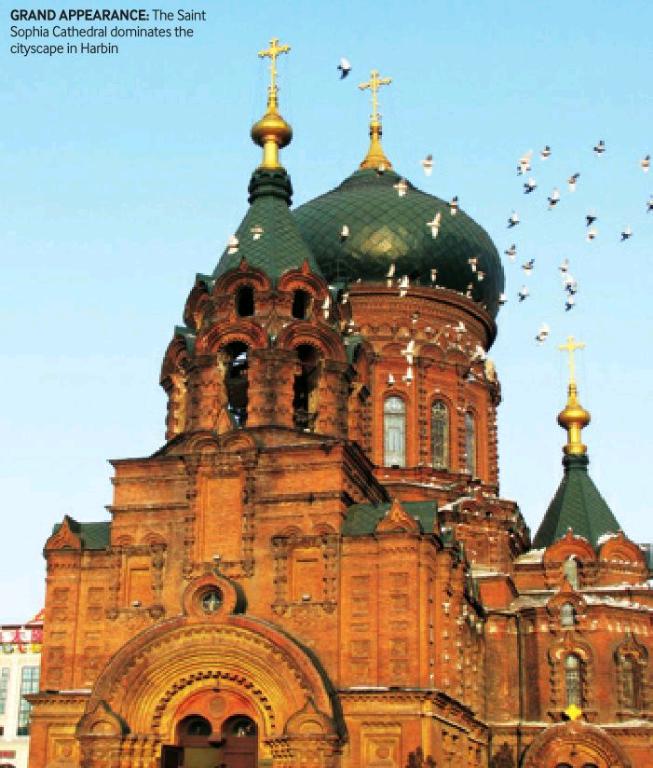From Russia,With Love
2014-09-23ByJiJing
By+Ji+Jing
Beautiful melodies echo throughout a newly refurbished synagogue in Harbin, capital of northeast Chinas Heilongjiang Province on the border with Russia, on an August evening. A small concert is being held by four female Russian violinists. The compositions they play include both Chinese songs, such as Butterfly Lovers and Jasmine Flower, and Russian ones, like Katyusha.
The synagogue is located on Tongjiang Street in Harbins Daoli District. It was built in the early 20th century, and has a history that spans more than 100 years.
“When the Chinese Eastern Railway began construction, a large number of Jewish Russians swarmed to Harbin. By the 1920s, the number of Jews living in the city had reached over 20,000,” said Li Shuxiao, a researcher with the Jewish Research Center of the Heilongjiang Provincial Academy of Social Sciences.
“The synagogue used to be a place for Jews to carry out religious ceremonies and political and social activities,” Li said.
Built by Russians in the late 1890s and early 1900s, the Chinese Eastern Railway ran across northeast China to link the Russian cities of Chita and Vladivostok. The railway centered on Harbin, with tracks stretching to Manzhouli, Inner Mongolia in the west and Suifenhe, Heilongjiang in the east and a southern branch reaching Dalian, Liaoning, measuring around 2,400 km in total. The route helped Russia divert natural resources from northeast China and strengthen its control of the Far East.
Harbin opened to foreign trade in 1905. At that time, many Western immigrants flocked to the city: Over 200,000 immigrants from more than 30 countries came to call Harbin home, and 19 countries set up consulates there. Soon after, the city developed into a highly international metropolis.
Russian culture has exerted the most prominent—and lasting—influence upon the city, among the Western cultures once present there. Just last year, the Harbin Municipal Government launched a 100-million-yuan ($16.3 million) project to revamp the old Russian Jewish synagogue to fit its original appearance. The project finished in May this year. The main hall of the synagogue has been transformed into a concert hall, designed for string instrument performances, and every week, four small evening concerts are put on in the building.
“The concert hall aims to provide a place for citizens, music lovers and tourists to listen to music,” said Qu Ming, Chairman of the Harbin Culture and Tourism Corp. “Its not enough to simply renovate the old synagogue. Putting on musical performances in the old building gives it new life.”endprint
The concert hall has given the city a vibrant musical atmosphere, together with the Harbin Summer Music Concert. This summer event was started in 1961 and has been held 31 times since. In 2010, Harbin was even awarded the title of a UNESCO City of Music.
Indeed, the city has always held a fascination for classical music lovers thanks to its Russian influence. In 1925, a Russian violinist and his wife founded the Glazunov Conservatory of Music, which is located near the synagogue. After a suspension of 78 years, it reopened in August.
The Harbin Conservatory of Music, another school of music that is currently under construction, will recruit students in two years. “The conservatory will cooperate with Russian music experts in the future to develop into a cradle for nurturing outstanding musicians,” said Lu Hao, Governor of Heilongjiang Province, on August 16 at the opening ceremony of a provincial tourism bureau-sponsored activity for the 100 top travel agencies in China. This activity was held to attract travel companies to offer more tour packages in the province.
“In the meantime, the conservatory serves to enrich the citys cultural atmosphere and improve Harbins image as an official City of Music,” Lu added.
Russia, redux
Western influence in the city, however, extends far beyond music. As a popular tourist destination, Harbins Central Avenue bears the strong imprints of Russian culture. Walking into a boutique along the avenue, one can find a bevy of Russian handicrafts for sale including matryoshka dolls, chocolates and candies, and many varieties of vodka. Shops selling Russian sausages can be seen up and down the street. One would not be remiss in mistaking Central Avenue for a street in Russia.
The avenue is now the most prosperous commercial area in Harbin and has become a must-see tourist destination. During peak season, it receives as many as 1 million visitors per day. Buildings that represent a variety of architectural styles, from the Baroque period to Art Nouveau, line both sides of the street to form a veritable gallery of Western architecture trends.
In the early 20th century, Russians—along with merchants from many other European countries—set up banks, stores, hotels, cinemas and bars along Central Avenue. Thus, the street recreated the fashions and prosperity of Europe at that time. The Saint Sophia Cathedral, a Russian Orthodox church that stands to the east of the avenue, provides a marked contrast to the markets hustle and bustle.endprint
“Harbin residents often come here not for the purpose of making any purchases, but simply to walk and relax,” said Geng Wei, a local tour guide.
The street was paved in 1924 with pieces of granite shaped like small Russian breads. At that time, it is said, the value of just one such stone could feed a person for a month. Thus, the avenue was dubbed a “street paved with gold.”
“On the one hand, Russians took advantage of many of the areas natural resources, but on the other, they left valuable legacies like the architecture in the city,” said Geng.
Wide-reaching influence
Russias mark upon the city is not only represented in such tangible forms as music and architecture, but pervades the lives of locals as well.
“The influence is everywhere,” said Liu Qinggang, an official with the Harbin Municipal Tourism Bureau. “For example, Russian people founded a beer factory in the city in 1900, the first beer brewery in all of China. Today, people here have kept up the brewing tradition.”
Since 1988, an annual beer festival has been held in Harbin each July. Drinking beer has become an important means for local people to socialize and negotiate business.
In addition to beverages, people in Harbin adopted their winter dress code from the Russians. In the worst of the cold, women wear thick fur coats, skirts and warm silk stockings.
“This way of dressing was first adopted from Russians and has been passed on through the present,” said Liu.
Governor Lu noted, “Though the per-capita income of Harbin residents does not rank high, their per-capita fashion industry consumption has often ranked among the top three highest in the country.”
Even the local love of picnics was adapted from Russian pastimes. On nice weekends, people spread out a sheet of cloth in one of the citys many parks and sit to enjoy food and beer with family and friends while feasting their eyes on the beautiful scenery.
“As summers in Harbin are very short, usually only two months long, people have to use the nice days for outdoor activities before the extremely cold winter returns,” Yin Feng, a local citizen, told Beijing Review.
Despite the unforgiving climate, Harbins distinct allure remains. “The city has offered me a unique taste of foreign culture,” said Wang Xiaolin, a visitor to the city. “As a famous Chinese tourist city, Harbin showcases a variety of foreign cultures to Chinese and foreign tourists.”endprint
